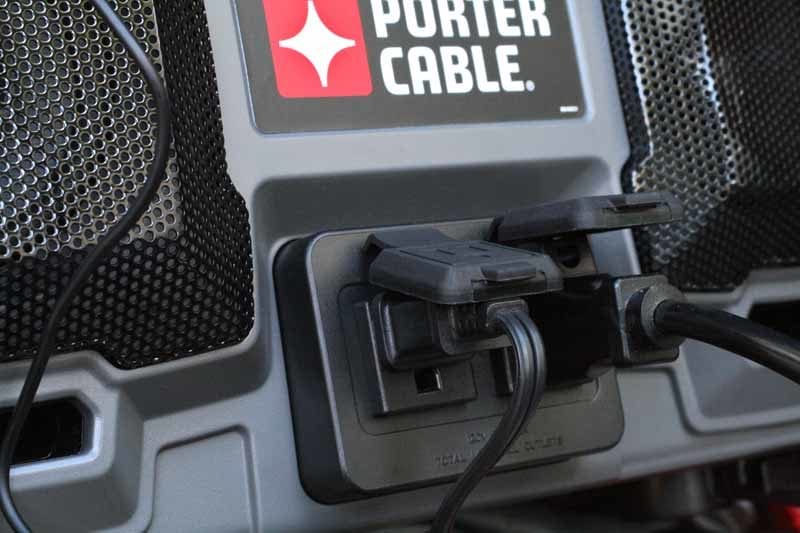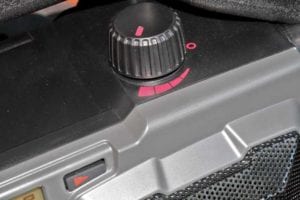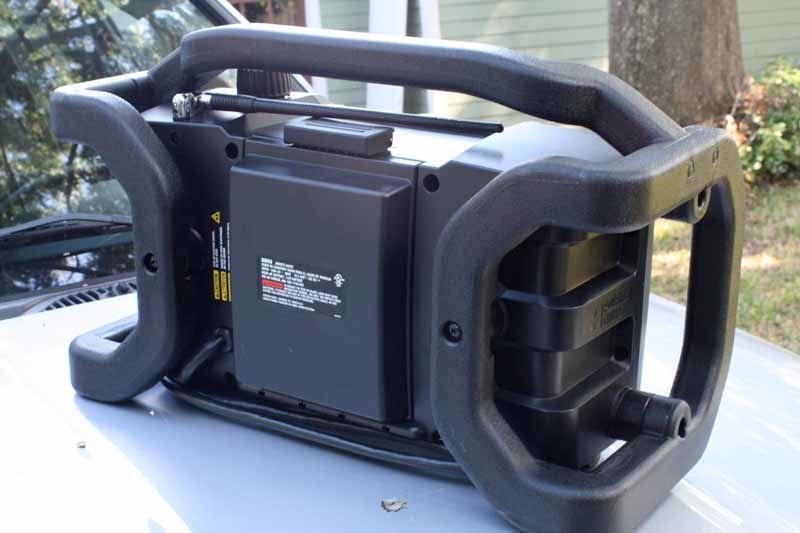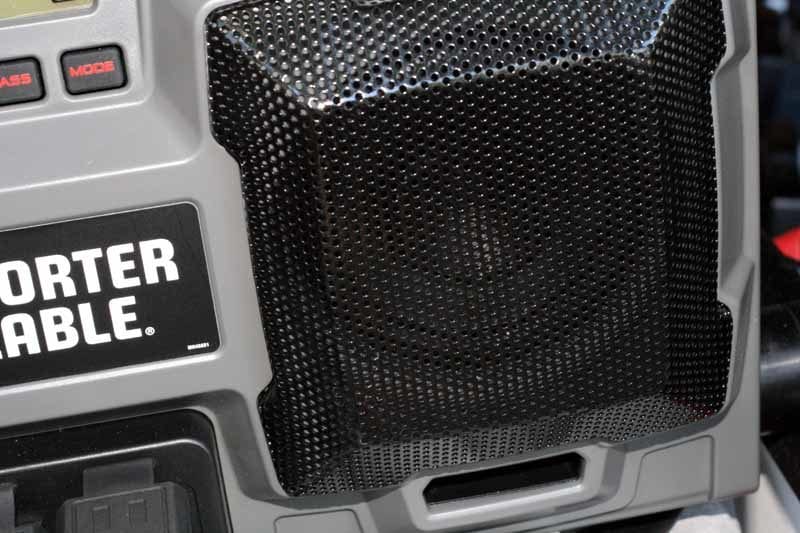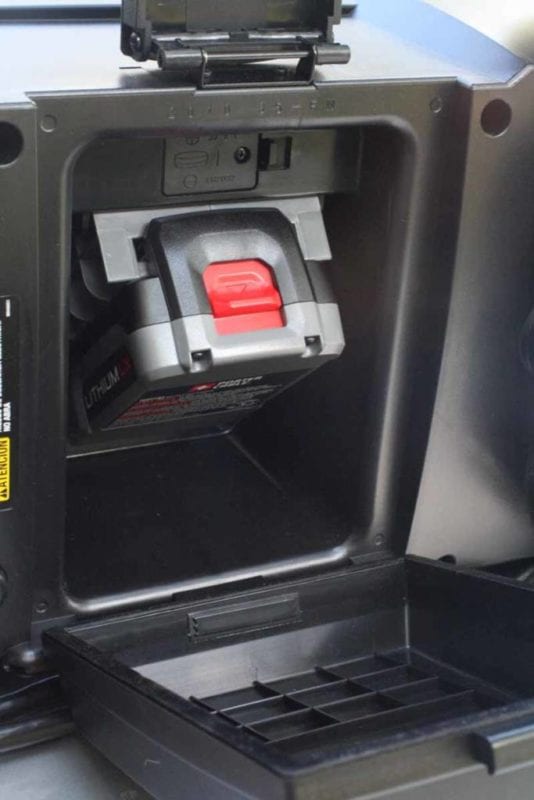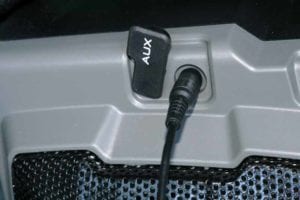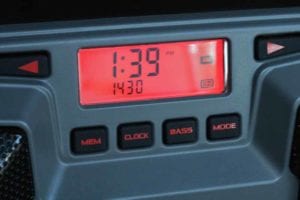We love jobsite radios. There’s nothing as satisfying as being able to blast your tunes at full volume while pounding nails. The Porter-Cable PC18JR 18V Cordless Jobsite Radio takes a neat turn in that they produced a great-sounding radio that doesn’t seem to distort – even when you max out the volume knob. It also offers some advanced features like giving you two pass-through 120V outlets, an AUX input for mp3 players, and a fully backlit LCD display. An integrated cord wrap and high-quality coaxial speakers mean that the unit is both convenient and capable of putting out good-sounding music. We also liked the integrated bass ports and the way the radio was easy to use, program, and haul around in our day-to-day work.
Editor’s Note: Check out our best jobsite radio article for our top picks.
Porter-Cable PC18JR 18V Cordless Jobsite Radio Features
Build Quality
We like to tear into things and see how they’re built. While we didn’t fully disassemble the PC18JR jobsite Radio, we did get a pretty good handle on how well it was constructed and what made it tick. For example, the dual bass ports at the bottom allowed the twin coaxial drivers to put out a lot more low-frequency information than they could have had they simply been dropped into a sealed compartment. It’s a good design and one that maximizes the capabilities of this radio (more on this later).
The volume knob is obscenely large, but that also means that you will be able to use it easily with or without gloves. The plastic “roll cage” is made of plastic and is secured to the main body of the radio by exactly six screws. Upon examination, the radio doesn’t feel like it could take a huge hit or fall without cracking the plastic – probably along one of the seam points or where the plastic is secured against the frame. It does, however, seem like the cage would break prior to the actual radio – and that might just be good enough for most people and the intent of the design.
As we mentioned, the actual speaker drivers are coaxial, meaning that there are two drivers nested within each other for reproducing both high and low frequencies. This gives each of the stereo channels a nice “full-range” sound that can dip down low and also extend into the higher frequencies without distorting or compressing.
On the back is a gasketed compartment for an 18V Li-ion or Ni-Cd battery pack. The seal ensures that dust and rain doesn’t get into the compartment and ruin the system. Between that and the coated poly speakers, this radio seems to be very weather-resistant. While the radio doesn’t include a battery or charger, it is compatible with all currently shipping 18V batteries from Porter-Cable, so if you’ve already got some tools, you can untether the radio from the wall and take it just about anywhere.
There is an AUX input in the front of the radio, designed for use with MP3 players (Porter-Cable’s website also said it could support “CD players” which, while technically true, made us laugh). The one thing we didn’t understand was the choice to place the AUX input on the front and not provide a larger capacity in the battery compartment to store a cell phone or mp3 player out of the elements. Instead, the Porter-Cable PC18JR radio gives you a short stereo mini cable and gives you a flat area at the top of the radio (above the LCD screen) on which to place your AUX device. This works, but won’t do you much good where you may not want your MP3 player exposed to dust or the elements.
Another major disappointment with the Porter-Cable PC18JR 18V Cordless Jobsite Radio is that it doesn’t charge the batteries when it is plugged into a 120V outlet. We’re finding this common in radios that don’t want to pay the license fee for DeWalt’s patent – but Porter-Cable is owned by Stanley Black & Decker so we figured it would be a no-brainer to include this feature and raise the price point, or at least provide a model that supported it. Keeping this I perspective, with the radio priced at $99, it’s hard to complain more than a little on this point.
Using the Radio
This radio is easier to use than my clock radio at home – much easier. In fact, the LCD controls are very intuitive. From setting the clock to adding stations to memory, everything just seemed to work well and with little thought. I did end up reading the user manual, but only after I had seemingly figured everything out. I certainly didn’t need it to understand any of the features. On the front panel, there is a Bass button that we found basically just adds boominess. There is definitely more bass with it engaged, but as with most bass enhancement features, it trades bass output for fidelity. Later we’ll talk about how this radio simply doesn’t distort the music, even at max volumes. With the Bass button engaged, it will so leave it off.
We loved the integrated cord wrap on the bottom of the unit, and the fact that the plug had a cord catcher, so it held fast and secure when stored. The antenna has a double hinge, so it can be laid flat and stored out of the way when not in use. It’s durable and rubberized so it looks like it will resist breaking, even if something bends it or falls onto it. There’s not a ton to say aside from the fact that this radio does what it claims, with little in the way of frills or features that distract from the ease of use.
Listening Tests
We liked the sound of the Porter-Cable PC18JR 18V Cordless Jobsite Radio. In particular, it was great to see them structure the output of the radio such that you could rarely get it to distort, even when you maxed out the source (in our case an iPhone 4) and the radio itself by slamming the dial all the way to the right. For reference, at the max volume, Classic rock tunes belted out at around 97dB SPL. If you like newer, highly-compressed pop, you’re likely to get even more volume out of the PC18JR. This is one of the louder jobsite radios we’ve heard, and we doubly liked that Porter-Cable didn’t sacrifice volume for quality . And let’s face it, if you need more than 97dB SPL at 1 meter you’re really expecting a lot.
We listened to a host of music, including classic rock from such artists as The Eagles, Little River Band and Heart. On Little River Band’s Greatest Hits album, “It’s a Long Way There” actually came across with some stereo separation and the kick drum had some punch – a feature almost unheard of in a “boom box” type product. Heart’s “Crazy On You” was phenomenal and we used this song to really check just how much the radio could put out without breaking up. It gave all it had and did it cleanly. Female vocals, which often point out immediate significant flaws, showed that Porter-Cable used decent coaxial drivers that reproduced decent sound, given the value and price point of the product. Compared to other radios on the market, I’d put the Porter-Cable PC18JR 18V Cordless Jobsite Radio near the upper end of the scale in terms of its sonic quality.
Conclusion
I’m rough on my stereo reviews. A jobsite radio has to be both tough and sound good in my opinion. And if it can’t play loud it isn’t much use. Basically, if you want an inexpensive jobsite radio with some bang-up features like basic protection and twin 120V outlets, the Porter-Cable PC18JR Cordless Jobsite Radio is a no-brainer. At $99 this is a Christmas or birthday gift you can rest assured will knock the socks off any loved one. You really can’t expect much more for $99. Highly recommended.


